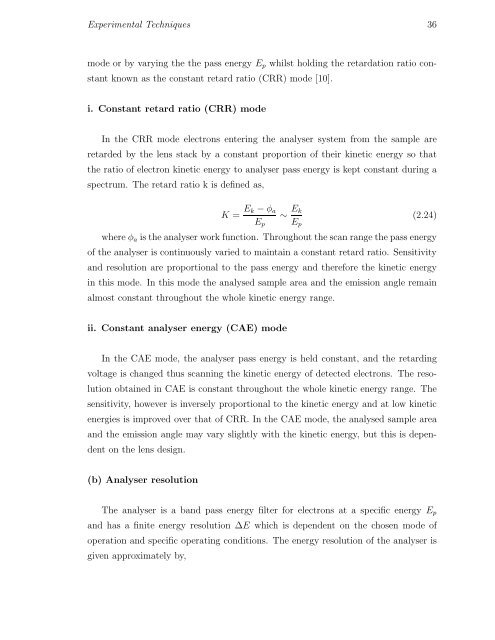PHYS07200604007 Manas Kumar Dala - Homi Bhabha National ...
PHYS07200604007 Manas Kumar Dala - Homi Bhabha National ...
PHYS07200604007 Manas Kumar Dala - Homi Bhabha National ...
You also want an ePaper? Increase the reach of your titles
YUMPU automatically turns print PDFs into web optimized ePapers that Google loves.
Experimental Techniques 36<br />
mode or by varying the the pass energy E p whilst holding the retardation ratio constant<br />
known as the constant retard ratio (CRR) mode [10].<br />
i. Constant retard ratio (CRR) mode<br />
In the CRR mode electrons entering the analyser system from the sample are<br />
retarded by the lens stack by a constant proportion of their kinetic energy so that<br />
the ratio of electron kinetic energy to analyser pass energy is kept constant during a<br />
spectrum. The retard ratio k is defined as,<br />
K = E k − φ a<br />
E p<br />
∼ E k<br />
E p<br />
(2.24)<br />
where φ a is the analyser work function. Throughout the scan range the pass energy<br />
of the analyser is continuously varied to maintain a constant retard ratio. Sensitivity<br />
and resolution are proportional to the pass energy and therefore the kinetic energy<br />
in this mode. In this mode the analysed sample area and the emission angle remain<br />
almost constant throughout the whole kinetic energy range.<br />
ii. Constant analyser energy (CAE) mode<br />
In the CAE mode, the analyser pass energy is held constant, and the retarding<br />
voltage is changed thus scanning the kinetic energy of detected electrons. The resolution<br />
obtained in CAE is constant throughout the whole kinetic energy range. The<br />
sensitivity, however is inversely proportional to the kinetic energy and at low kinetic<br />
energies is improved over that of CRR. In the CAE mode, the analysed sample area<br />
and the emission angle may vary slightly with the kinetic energy, but this is dependent<br />
on the lens design.<br />
(b) Analyser resolution<br />
The analyser is a band pass energy filter for electrons at a specific energy E p<br />
and has a finite energy resolution ∆E which is dependent on the chosen mode of<br />
operation and specific operating conditions. The energy resolution of the analyser is<br />
given approximately by,
















